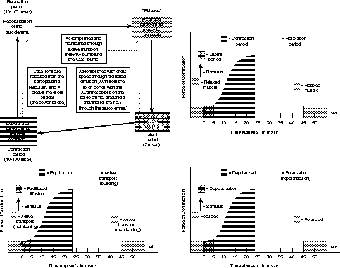Anatomy and Physiology: You've Fallen into My Treppe!
You've Fallen into My Treppe!
Each muscle twitch is a brief event. Because of the rapid breakdown of ACh, the myofiber starts to relax almost as soon as it starts to contract! Such a contraction cannot be full strength. If a second stimulus happens in the middle of the relaxation period, the strength of the resulting contraction will be a combination of the strength of the contraction at the point of the second stimulus, as well as the new contraction. This summative effect is called the staircase effect, or treppe, because of the staircase-like appearance of the myogram (treppe means staircase in German).

Figure 8.4If you compare the flow chart of membrane transport with the various labeled myograms, you will see that they are representative of different versions of the same event. (©Michael J. Vieira Lazaroff)
If you have ever heard of, or hopefully had, a tetanus shot, you probably think of tetanus as a bacterium. The bacterium, however, got its name—Clostridium tetani—from the sustained muscle contraction known as tetanus. In incomplete tetanus the muscle reaches peak strength, but it cannot maintain it (the relaxation period is allowed to start) due to the frequency of the stimuli from the motor neuron. When there are more frequent stimuli the relaxation period is not allowed to start, which results in a sustained contraction known as tetanus. (An infection with the tetanus bacterium affects muscle cells, causing sustained contractions where they are not wanted. For this reason tetanus, which is sometimes called lockjaw, can be fatal if untreated.)
Ca2+, Not Just for Healthy Bones!
Following all of this influx of Na+ ions, a whole series of events occurs. The endoplasmic reticulum in muscle cells not only has a special name (the sarcoplasmic reticulum or S.R.), but it also has a special function. The S.R. acts as a calcium storage device (see Figure 8.5). Similar to the sarcolemma, the S.R. maintains a high concentration through active transport. One difference in the S.R. is the presence of a protein, with a really cool name, by the way, that helps to store the calcium: calsequestrin. Like a sequestered jury, the calcium, which is in its ionic form, Ca2+, the Ca2+ is held in place by that protein.

Figure 8.5The conjunction of transverse tubules, and the layout of the sarcoplasmic reticulum, speed up the release of Ca2+ ions into the sarcomere. (©2004 Pearson Education, Inc., publishing as Benjamin Cummings)
It's a good thing, too, because that Ca2+ can't be trusted. Its release, also through facilitated diffusion, triggers the actual contraction phase of the muscle. It turns out that the exocytosis of acetylcholine through the presynaptic membrane starts a chain reaction—first the influx of Na+ through the postsynaptic membrane, then the exodus of Ca2+ ions out of the S.R., and then, well, you'll find out in the moving proteins section!

Excerpted from The Complete Idiot's Guide to Anatomy and Physiology © 2004 by Michael J. Vieira Lazaroff. All rights reserved including the right of reproduction in whole or in part in any form. Used by arrangement with Alpha Books, a member of Penguin Group (USA) Inc.
To order this book direct from the publisher, visit the Penguin USA website or call 1-800-253-6476. You can also purchase this book at Amazon.com and Barnes & Noble.
